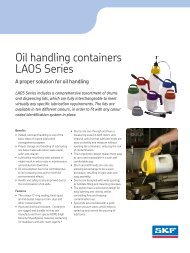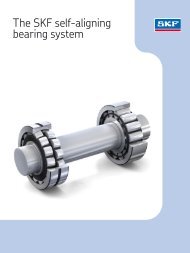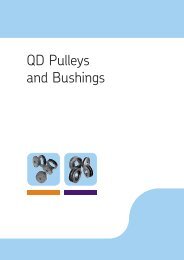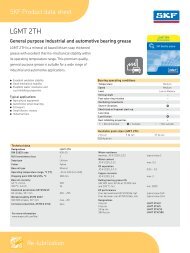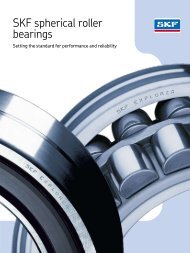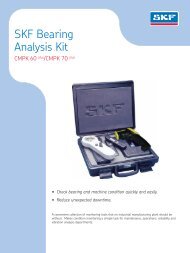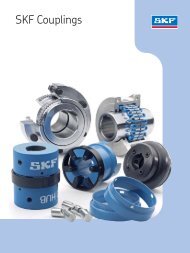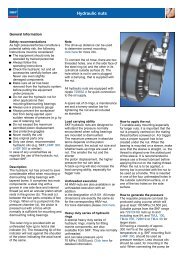SKF Maintenance and Lubrication Products
SKF Maintenance and Lubrication Products
SKF Maintenance and Lubrication Products
You also want an ePaper? Increase the reach of your titles
YUMPU automatically turns print PDFs into web optimized ePapers that Google loves.
Technical data<br />
Underst<strong>and</strong>ing grease technical data<br />
Some basic knowledge is required to underst<strong>and</strong> the technical data so that you<br />
can select the proper grease. This is an excerpt of the main terms mentioned in<br />
<strong>SKF</strong> grease technical data.<br />
Consistency<br />
A measure of the stiffness of a grease. A proper consistency must<br />
ensure that the grease stays in the bearing without generating too<br />
much friction. It is classified according to a scale developed by the NLGI<br />
(National Lubricating Grease Institute). The softer the grease, the lower<br />
the number. Grease for bearings are typically NLGI 1, 2 or 3. The test<br />
measures how deep a cone falls into a grease sample in tenths of mm.<br />
Viscosity<br />
A measure of a fluid’s resistance to flow. For lubricants, a proper viscosity<br />
must guarantee an adequate separation between surfaces without<br />
causing too much friction. According to ISO st<strong>and</strong>ards, it is measured at<br />
40 °C (105 °F), as viscosity changes with temperature. Values at 100 °C<br />
(210 °F) allow calculation of the viscosity index, e.g. how much the<br />
viscosity will decrease when temperature rises.<br />
Classification of greases by NLGI consistency number<br />
NLGI<br />
number<br />
ASTM worked<br />
penetration<br />
(10 –1 mm)<br />
Appearance<br />
at room<br />
temperature<br />
000 445–475 very fluid<br />
00 400–430 fluid<br />
0 355–385 semi-fluid<br />
1 310–340 very soft<br />
2 265–295 soft<br />
3 220–250 medium hard<br />
4 175–205 hard<br />
5 130–160 very hard<br />
6 85–115 extremely hard<br />
Temperature range<br />
Comprehends the suitable working range of the grease. It goes between<br />
the low temperature limit (LTL) <strong>and</strong> the high temperature performance<br />
limit (HTPL). LTL is defined as the lowest temperature at which the<br />
grease will allow the bearing to be started up without difficulty. Below<br />
this limit, starvation will occur <strong>and</strong> cause a failure. Above HTPL, the<br />
grease will degrade in an uncontrolled way so that grease life cannot be<br />
determined accurately.<br />
Dropping point<br />
Temperature at which a grease sample, when heated, will begin to flow<br />
through an opening according to DIN ISO 2176. It is important to<br />
underst<strong>and</strong> that this point is considered to have limited significance for<br />
performance of the grease as it is always far above HTPL.<br />
Mechanical stability<br />
The consistency of bearing greases should not significantly change<br />
during its working life. Three main tests are normally used to analyse<br />
this behaviour:<br />
• Prolonged penetration<br />
The grease sample is subjected to 100 000 strokes in a device<br />
called a grease worker. Then, the penetration is measured.<br />
The difference against penetration at 60 strokes is reported<br />
as the change in 10 –1 mm.<br />
• Roll stability<br />
A grease sample is placed in a cylinder with a roller inside. The<br />
cylinder is then rotated for 72 or 100 hours at 80 or 100 °C<br />
(175 or 210 °F) (the st<strong>and</strong>ard test dem<strong>and</strong>s just 2 hours at room<br />
temperature). At the end of the test period, once the cylinder has<br />
cooled to room temperature, the penetration of the grease is<br />
measured <strong>and</strong> the change in consistency is reported in 10 –1 mm.<br />
• V2F test<br />
A railway axlebox is subjected to vibration shocks of 1 Hz from a<br />
bouncing hammer producing an acceleration level between 12–15 g.<br />
After 72 hours at 500 r/min., the grease leaked from the housing<br />
through the labyrinth seal is collected in a tray. If it weighs less than<br />
50 g, a rating of ‘m’ is granted, otherwise it is rated as ‘fail’.<br />
Afterwards, the test is continued for another 72 hours at 1 000 r/min.<br />
If less than 150 grams of grease leaked after completion of both tests,<br />
then a rating of ‘M’ is given.<br />
136




